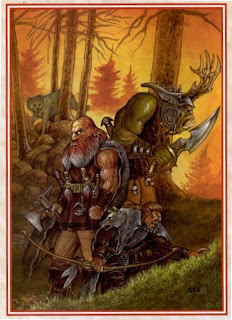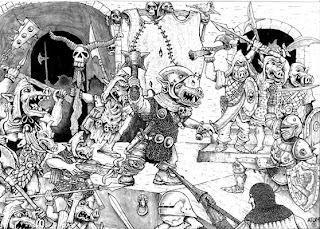The Warlord II - Allies, Followers, and Slaves
Loyal followers are the most valuable “possessions” these villains can have. Undoubtedly, a betrayal at some point in the past has cost our ancient villain a great deal. Certainly, magical items are helpful, but these can be found, stolen, bartered for, or made. Followers, on the other hand, must (in most cases) be courted, recruited, and trained. They represent a great investment in time and energy. They are allowed or encouraged to grow powerful in order to serve better, but they are watched carefully to see that they do not gain enough power to become a threat to their master. This is not to say that these villains are kind and benevolent to their minions. The methods that evil-aligned creatures use to obtain loyalty differ from the methods of good-aligned creatures, but they can still be effective.
At the very bottom tier of the ancient character’s retinue are slaves and charmed victims. These are unwilling followers who probably revolt if given the opportunity and some hope of success. For this reason, they are given menial jobs and little or no trust. They have close supervision, and their failures are acted upon immediately. Most ancient monsters have at least one or two slaves, but drow have as many as they can keep. Giants tend to have a small group of slaves, and fiends may even have lesser fiends to serve them. Nagas and certain fiends keep charmed followers, as do vampires and many spellcasters with the appropriate spells.
Followers who are loyal of their own choice usually have magical items if it is possible for their master to acquire them. Naturally, the master saves the best for himself, but he gives lesser items to those followers who can best use them. When it comes to normal equipment, loyal followers tend to have the best that gold can buy. Armor, weapons, and steeds are the best quality available. Such gifts are a cheap price to pay for continued loyalty. Willing followers are aware of their master’s wishes and endeavor to live up to his expectations. They are alert, follow directions to the best of their ability and intelligence, and fight fiercely to protect his interests.
Ancient villains also typically have allies of varying degrees. Some share identical goals, while others have ambitions that only marginally coincide with the ancient villain’s. A rakshasa slaver might know a mind flayer to whom he had sold slaves on occasion. In return for a couple of choice elves, some tough dwarves, and a brilliant gnome, the mind flayer might provide the rakshasa with some adamantite from the Underdark, release the rakshasa’s wild talent, or use his psionic powers to take the rakshasa to another place or plane.
One loyal servant very important to a monstrous villain is a human or a human appearing creature who can interact with human society. Humans have (in most worlds) the largest centers of population, and much trade goes through their hands. They also have powerful magic and many humans can be found who are willing to deal with evil creatures or who don’t care about good or evil.




Comments
Post a Comment